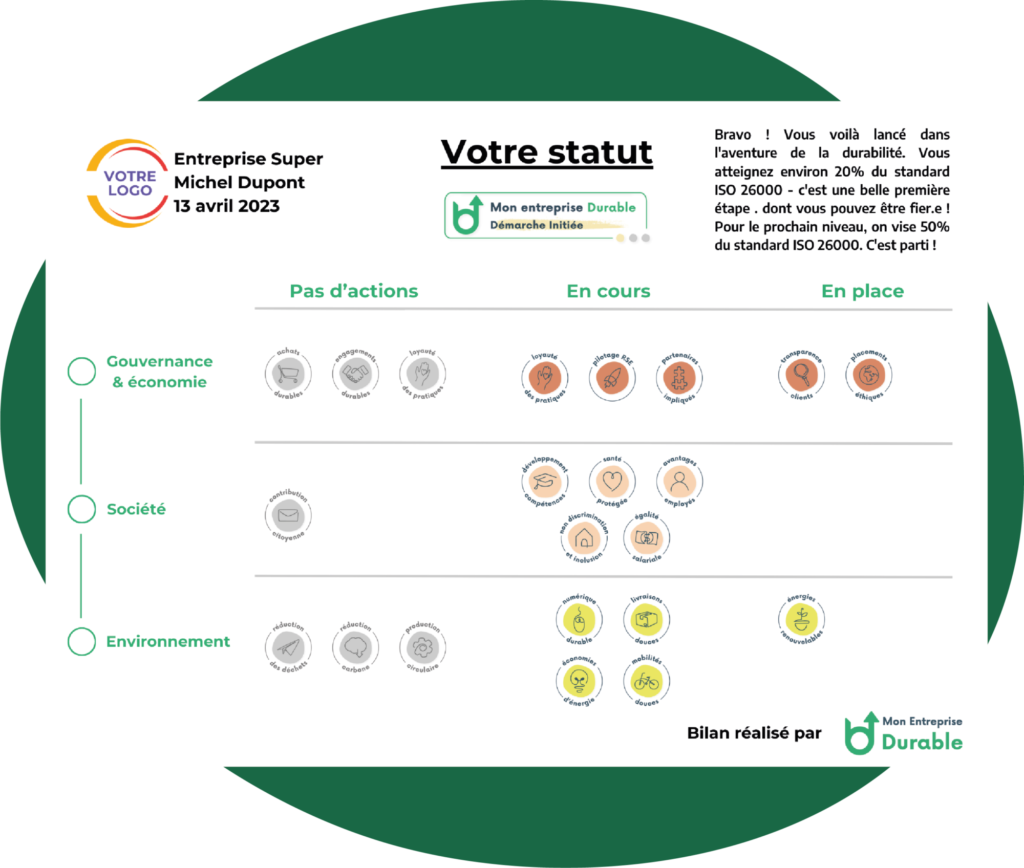A few words about us before you start reading
Welcome to Mon Entreprise Durable par Coptain! In a nutshell, our job is to enable CSR managers to multiply their impact!
Want to know how it’s done?
EcoEntreprise certification is a high-quality certification recognizing companies committed to sustainable, environmentally-friendly practices.
Obtaining this certification can generate numerous benefits, including cost reduction, competitive advantages and regulatory compliance.
However, the certification process can seem complex and demanding.
That’s why this article aims to guide you through the steps required to prepare effectively for EcoEntreprise certification, highlighting specific examples and practical advice.
Key points of the article
Understanding EcoEntreprise certification criteria
Before starting the certification process, it’s essential to understand the criteria your company will have to meet, so that you can fully understand the expectations and implications of certification. The criteria on the complete EcoEntreprise checklist cover many aspects of sustainable management. They are grouped into six categories:
Leadership and management: commitments, organization, management and strategy, services and missions, monitoring, continuous improvement, communication and reporting
Society: governance, dialogue with stakeholders, societal issues
Internal processes: product and service design, purchasing, projects, emergencies, mobility and transport, administration, infrastructure, sites
Environment: resource consumption, emissions, pollution and other nuisances, environmental risks, water, air and odours, energy and climate, waste, noise, chemistry and biotechnologies, biodiversity, natural environments and landscape
Social: workplace safety, health, social issues and quality of life
Economy: sustainability, innovation and risk management, creation of added value compatible with sustainable development.
This EcoEntreprise checklist is an extremely practical reference for assessment (and even guided self-assessment).
You’ll find it on the Okpilot web tool.
The main advantage of this procedure is that it can be adapted to any type of organization, as it is scalable and adaptable according to business sector or company size.
Step 1: Conduct a self-assessment
The first step is to carry out a self-assessment of your current environmental practices.
Use the OK pilot tool provided by the certification body and its free 30-day trial version. to identify the areas in which your company excels and those in which it needs to improve.
This step can be very useful, and will already put you on the right track by giving you not only an initial diagnosis, but also a clearer idea of the goals you need to achieve.
Step 2: Draw up an action plan
Based on the results of the self-assessment, draw up an action plan to improve your environmental and social practices. This plan should include specific objectives, concrete actions and deadlines.
Why is a CSR audit with Mon Entreprise Durable by Coptain on average 3x faster and 6x cheaper?


Why is a CSR audit with Mon Entreprise Durable by Coptain on average 3x faster and 6x cheaper?
Step 3: Implement the action plan
Once the action plan has been drawn up, it’s time to implement the actions needed to improve your environmental and social practices. Make sure that each action is closely monitored and that progress is regularly assessed. This action plan may involve technical/technological developments, such as the installation of solar panels, or structural and attitudinal changes. We contacted Camandona SA, certified EcoEntreprisecertified company, and they gave us a few examples of the action they have taken. These include the development of renewable energies for the most electricity-intensive jobs, and the reinforcement of environmental monitoring of worksites: water and waste management in particular, which is essential for a construction company.
Step 4: Raise awareness and train your employees
Awareness-raising and training are essential to the success of your sustainability initiatives. Organize training sessions and workshops to inform your employees about environmental and social issues, and best practices. For example, you can educate your staff on the use of eco-friendly materials, better waste management, energy efficiency and so on. Of course, these training courses vary according to your sector of activity. At Camandona SA, CSR procedures have been defined and supplemented by manuals designed to enhance the skills and respect the integrity of each employee. Training courses are offered at regular intervals.
Step 5: Monitoring and evaluation
It’s essential to regularly monitor and evaluate your progress to make sure you’re on track for EcoEntreprise certification.
Use performance indicators to measure your results, and adjust your action plan if necessary.
For example, you can set up an energy consumption tracker to assess the impact of your energy-saving policy.
The more data you have at your disposal, the easier it will be to adjust your decisions.
Step 6: Prepare for the external audit
The external audit is the final stage in the certification process.. Prepare yourself by gathering all the necessary evidence and documents to demonstrate your compliance with the certification criteria. Make sure that all employees are aware of the audit, and that they are prepared to respond effectively to the auditors’ questions. It may be useful to organize a training session to prepare your employees effectively for the auditors’ questions. There are six bodies accredited to carry out certification audits. You are therefore obliged to use one of the following organizations from the following listbut you’re free to choose which one.
To conclude...
Preparing for EcoEntreprise certification requires careful planning and rigorous implementation.
By following the steps outlined in this article, you can ensure that your company is fully prepared to meet the expectations and objectives of certification, and maximize your chances of obtaining this quality certification.
EcoEntreprise certification will not only enable you to improve your environmental and social practices, it will also enhance your reputation and competitiveness in the marketplace.





